Julie Schnidman & Annie Yeh
Chicago, Illinois, USA
Science and art play integral roles in shaping the content of Hektoen International. Therefore, we wanted to highlight the work of three artist/scientists from the Chicago area and explore the influences behind their eclectic career paths. We met Hunter Cole, Peter Gray, and Vesna Jovanovic at a panel discussion sponsored by ArtSciChicago, a forum dedicated to connecting scientists, artists, and everyone in between. Hunter Cole is a geneticist, a professor of biology and art at Loyola University Chicago, and a professional artist whose work has been featured internationally. Peter Gray is a sculptor and founder of Metal-i-Genics Studio; he has also served as an art/science educator at Dixon Elementary School in Chicago. Vesna Jovanovic is a visual artist with an academic background in fine arts, photography, and chemistry. Through a series of questions, we engaged them in a discussion about scientific artfulness and artful science.
How has your educational background in science overlapped with your interest in art? Which came first?
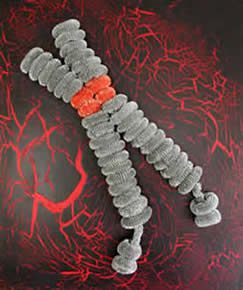 |
|
Royal couple – Queen Fragile X |
Cole: I have always enjoyed art and science. Growing up in San Francisco, my dad regularly took me to the Academy of Sciences Museum and the de Young Museum. While I enjoyed drawing and photography growing up, my educational pursuits were always towards the sciences. I went to a science and math magnet high school in San Francisco and then studied plant biology at the University of California, Berkeley. When I was pursuing my PhD in Genetics, I often became frustrated when my experiments didn’t work out as planned. Painting was a way for me to release the frustrations I was having as a scientist. The more I created, the more I started to see the potential of integrating my science with my art.
Gray: I always enjoyed my high school science courses: biology, chemistry and physics. I recall one of my favorite projects in one of these classes was creating India ink drawings. I was studying and making art before I considered becoming a scientist. It wasn’t until my third year of undergraduate studies that
 |
|
Ribcage vessel |
I decided some kind of biomedical research was my “chosen” path. Genetic molecular techniques were just becoming exciting, so I undertook research at a medical school. In my first five months of postgraduate science study, I generated more art than science. Some of my artwork during this period was done to present an artistic visualization of science to nonscientists. Other artwork also completed during this period focused on non-scientific concepts such as social injustices toward African Americans. My work is now approximately 75% science-derived with other contemporaneous subjects included sporadically.
Jovanovic: For as long as I can remember, I had a desire to pursue art both academically and professionally; I wanted to be an artist when I grew up. Somewhere along the way I also became interested in science, which, by the time I was in college, led to a major in art with a minor in chemistry. Although I attended a liberal arts university that had identical core requirements for any chosen field of study, I found myself academically divided. I quickly discovered that the course prerequisites made it impossible to minor in chemistry without majoring in another science-related field. This is partly why I ended up turning my chemistry minor into a second major and degree. What I observed and found interesting was just how little academic overlap there was between the arts and sciences, from the physical separation of buildings on campus, to the different ideologies that permeated each department. I felt like an outsider in both departments because my loyalties were divided. I didn’t have an exceptionally partisan attitude toward either department or field; I was simply interested in exploring and discovering new things. As far as timelines go, art did come first and stayed for the long run, but science definitely left a lasting impression on me along the way.
What inspires you to create art from scientific concepts?
Cole: Combining art and science seems natural to me. I use scientific media like living bioluminescent bacteria as an artistic medium to illuminate subjects in photographs and create drawings. For example, in my Living Light Series, I photograph people and objects from which the only light source in the photographs comes from living bioluminescent bacteria. In the Living Drawings series, I start by creating line drawings using the bacteria, then allow the bacteria to grow on Petri dishes. Bacteria gradually become collaborators in the art as they grow and die. An example of that is Rabbit, where the initial drawing, Rabbit: Stage 1, shows a rabbit on the right and a rooster on the left. After some of the bacteria die in Rabbit: Stage 2, the rooster on the left becomes a wolf. I created the initial drawing intentionally, but would have never been able to predict that the rooster would transform into a wolf in its final stage. The bacteria contributed to the story in the art. These living drawings not only shed light on the creative process in designing bioart, but also depict the cycle of life and death.
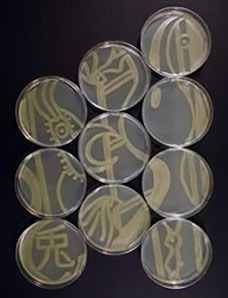 |
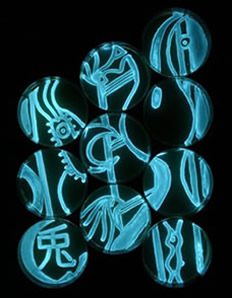 |
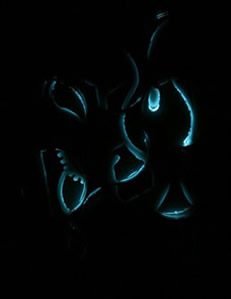 |
|
Rabbit (room lights on) |
Rabbit: Stage 1 (room lights off) |
Rabbit: Stage 2 (room lights off) |
Gray: As an artist and sculptor, I am constantly amazed by the beauty and harmony in molecular structures and their functions. Inspiration comes from my observations in the laboratory, the scientific literature I read, and my role as a science educator. As an educator, I present science in a manner that is palatable to the general public and helps them realize they can understand it. I attempt to do this not only through my lectures and classes, but also through the inclusion of art in my curriculum. I have found that art, particularly sculpture, can be used to generate a significant amount of interest in genetic science for elementary school students (grades 6 to 8). Basic genetics is often taught by me in conjunction with sculpture for this very reason. My unique role as science educator and artist allows me to use art as a vehicle to translate the formal language of science into examples that can be understood by anyone.
Jovanovic: As an art student, I was initially interested in philosophical approaches to nature; I was interested in questions such as: “What is nature? How does one define its boundaries? How are we a part of it?” These ideas were, indirectly, related to science.
The more direct scientific influences in my artwork showed up later. When I left school and began focusing solely on art, I found myself missing science. This manifested itself in my artwork. I began drawing laboratory equipment, which eventually “mutated” and combined with other ideas into a strange amalgam of fictional laboratory paraphernalia and body parts.
Tell us about a specific piece of art you created which represents an unconventional view of science or challenges scientific research.
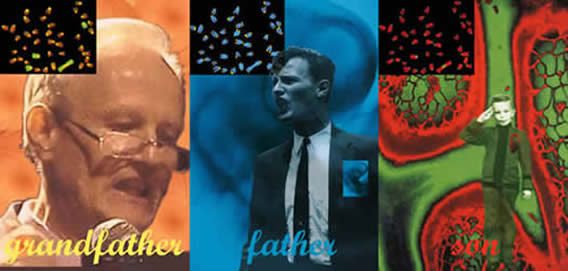 |
|
Let my family live! Portrait of Randolfe Wicker, the first human cloning activist |
Cole: In my art related to cloning and stem cells, some of the viewpoints I express are contrary to popular public opinion. My goal is not necessarily to change opinions, but to have people consider a new viewpoint they may not have thought of previously.
For example, in Let my family live! Portrait of Randolfe Wicker, the first human cloning activist, I put forth the idea that a human clone would be a unique individual rather than the carbon copy that gets portrayed in the media. Randolfe H. Wicker is the world’s first human cloning activist. My piece features actual photographs Wicker integrated with images from the microscopic world. Wicker is shown at different stages in his life with the words “grandfather,” “father,” and “son” underneath his photographs and his potential human clone descendants, all very similar yet unique. It is important for people to understand that a human clone may have the same DNA genome as another, but if born, would be an individual with a unique personality and soul. The human clone would have different cultural influences in a different time in history and a different upbringing in a different family situation. Some people assume that this artwork is intended to promote human cloning, but its intention is to have people consider a new perspective on cloning.
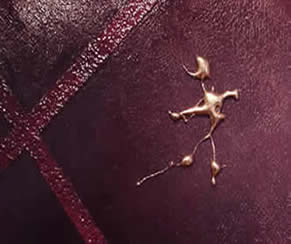 |
|
HeLa’s legacy |
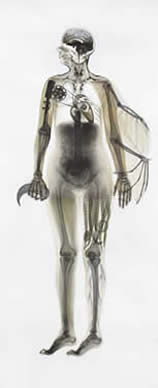 |
|
Timekeeper |
Gray: I think scientist/artists stay true to their craft by challenging prevailing scientific research. Similar to Ms. Cole’s work, my piece HeLa’s Legacy also considered the topic of stem cell research. This piece is a tribute work to Henrietta Lacks, an African American woman who was an unknowing donor of what became an immortal cell line used for extensive biomedical research. Until recently, she was relatively unknown by scientists and the general public alike. In the 1950s, her physician took a sample of cancer cells from a tumor she had removed and while using the sample in his lab to study how cancer cells grow, found that her cells were capable of reproducing in the lab for extended periods. In fact, her cells became known as the “HeLa cell line” and have been used ever since for studying cell functions. I worked on these cells and always felt connected to them. A photomicrograph from one of my experiments was used to create a sculptural painting. The cell I chose looked like a person dancing. Only later did I learn that Henrietta Lacks was a ballet dancer. Today, there is renewed interest in Ms. Lacks regarding how the medical research community used her cells without consent from her or her family members. However, recent reports seem to only consider the 1950s situation using today’s standards for consent and compensation. I hope HeLa’s Legacy will ignite a conversation around this controversy and encourage others to think critically about the ethical implications of cell research.
Jovanovic: I wouldn’t say that my work challenges scientific research so much as it offers an alternative form of inquiry. Timekeeper is probably my most recognized piece in this regard. I created it by digitally composing my own collected medical scans into a life-size file, outputting the file as a waterproof archival print, and then drawing and painting directly onto the print. The initial composite struck me as an illustration of various periods in my life that all came together in a cohesive image of my body. The presence of time was immediate: time through evolution, one’s lifetime, time through technology, art, etc. The resulting combination represents the body in a way that wouldn’t be taken seriously within the scope of science. It includes x-rays, MRI’s, CT Scans, as well as drawn images of an imaginary machine arm, an octopus leg, bat and bird wings, a geared heart, a halo, etc. Nevertheless, I find it to be a more complete representation of a human body than one that simply illustrates its physical aspects.
What is the purpose of your art? What do you hope to achieve through your work?
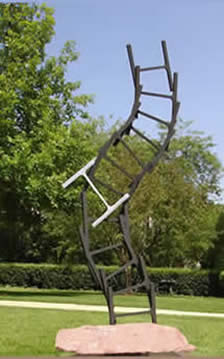 |
|
Point mutation |
Cole: I believe that art and science can enhance one another. Their integration may lead to new discoveries in science and the exploration of new media in art with novel meanings. I use my art to provoke my audience into thinking about weighty scientific issues. The viewpoints I conjure up in my artwork are meant to engage the viewer to hopefully form opinions about controversial topics in science, or at the very least think critically about them.
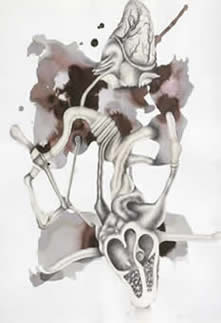 |
|
Ventricles apart |
Gray: My artistic mission is to introduce art in a nontraditional context, piquing my audience’s interest in the material so that they will seek additional knowledge. The concepts I apply to my artwork are culled from my multidisciplinary training in biomedical science and art. Each piece is designed to awaken the inner scientist in everyone.
The science is a jumping off point for me. How something scientific is represented varies with the purpose of the artwork. As artists we must do more than replicate what we see; we must enhance, reinforce and/or challenge the status quo. It is my intention and ultimate goal to initiate in the viewer a response of recognition or a question from my work.
Jovanovic: I’ve always seen the purpose of art and that of science as complementary to each other. If the purpose of science is to seek answers to what we do not yet know, perhaps the purpose of art is to question what we think we already know. With this in mind, I can see how the two disciplines can often be viewed as being in opposition to one another, but to me they are two sides of the same coin. I never saw art as a “form of expression” or a “quest for beauty.” I think these clichés have been falsely ascribed to artists. Art may appear to have the purpose of expression or beauty when seen from the perspective of the viewer, historian, or critic, but I do not believe that most artists enter the field with egotistic or hedonistic motives. There is always an exploration at hand. Making art often feels like a curious quest for a new way of perceiving something, but that is probably putting it too simply.
I think it is safe to say that science is often perceived as more valuable than art in its purpose. I am basing this on the amount of funding, public attention, and common daily references to both fields. I think that this imbalance is detrimental to humankind. As much as we find it useful to seek structure and make sense of the world, it’s just as important to examine and investigate our paradigms and biases. Art can provide a forum for questioning these presumed truths.
HUNTER COLE is an artist and geneticist whose work has been exhibited internationally. She reinterprets science as art through abstractions, digital art, and installations. She holds a PhD in Genetics from the University of Wisconsin-Madison and teaches biology and art at Loyola University Chicago. She created a course, Biology Through Art, where students have the opportunity to create innovative artworks in a biology laboratory.
hicago. He has had solo and group sculpture exhibitions in Chicago, New York, and San Francisco, United States and in Innsbruck, Austria. For the past two years, he has been using the National Geographic Society’s Genographic Migration project to teach sculpture and genetics in a special elementary school program on Chicago’s South Side. He gives lectures on Genetics and Sculpture, Science, and Art and has developed a series of plays relating to genetic technologies in today’s life for a theater company. Mr. Gray received training in art and graphics design at the Delaware Art Institute. He received his scientific training at the University of Delaware, Northwestern University Medical School, and the Graduate School of Biomedical Sciences at the M. D. Anderson Tumor Institute. Peter’s website is http://www.metal-i-genics.com.
VESNA JOVANOVIC is a visual artist who works in a wide range of media, from pinhole photography, to surrealist drawings and ceramics. She holds BA and BS degrees from Loyola University Chicago, where she received 1st place at the senior art exhibition. She also holds a BFA from the School of the Art Institute of Chicago, where she was granted a Merit Scholarship of Recognition. Her MFA degree is from the Ohio State University. Jovanovic is a recipient of several awards and grants, including a CAAP grant from the City of Chicago Department of Cultural Affairs and the Illinois Arts Council. She has been featured in several magazines and blogs including Time Out Chicago, Newcity, Seed, Art:21, and Discover. Her artwork has been included in over fifty exhibitions, including solo exhibitions at the University of Chicago Gordon Center for Integrative Science, the International Museum of Surgical Science, and the Contemporary Art Center of Peoria. Vesna’s website is www.vesnaonline.com.
JULIE SCHNIDMAN AND ANNIE YEH are contributing authors to this feature. They also serve as associate editors of Hektoen International. In addition to her editing responsibilities, Ms. Schnidman coordinates educational programs and assists the Pre-award Grants Administration department at Hektoen Institute. Ms. Yeh currently attends medical school at Louisiana State University, Class of 2014.
Highlighted in Frontispiece Winter 2011 – Volume 3, Issue 1
Winter 2011 | Sections | Gallery

Leave a Reply